The growth of cloud technology has created the perfect ecosystem for Saas products to thrive. Today, Saas products are among the fastest-growing segments in the I.T. industry. Businesses today use an average of 80 SaaS apps for their operations. According to fortune business Insight, the global saas market size is projected to grow from $130.69 billion last year to $716.52 billion in the next 6years.
If you are quite enthusiastic about getting on board the saas space, now may be the best time to develop your saas product and tap into the limitless possibilities the emerging market offers. As a custom software development company, we will like to share our wealth of experience developing saas applications with you. However, before we get into the core aspect, let us take a tour of SaaS basics.
Table of Contents
What is a SaaS Product?
✅ As against the traditional licensing model, SaaS or software as a service is a cloud computing model of delivering an application over the web in the form of service. Here users of the service need not install or maintain the software; rather, they simply access it via the internet. Thus exonerating themselves from the rigours of software and hardware management.
✅ Saas products are sometimes referred to as web-based software or hosted software since the products are run on the SaaS providers’ servers. For instance, Shopify and Netflix are two well-known SaaS application that offers users access to their services without necessarily running any installation. The host site is responsible for all updates and subsequent maintenance. However, users may be charged on a subscription or pay-as-you-go basis to access these platforms.
SaaS Product Market Overview
SaaS delivery model, an emerging technology trend, is predicted to maintain upward momentum in the foreseeable future. According to Statista, in 2020, the saas global market size was around $120.82 billion, and it grew to $152.69 billion in 2021. The global market size is projected to gross $208.1 billion at this current rate by 2023.
The growth in the SaaS segment is not unconnected to the increased demands for SaaS products during the pandemic and the continued adoption by businesses in the post-pandemic markets. Between January 2020 and September 2021, Salesforce grew from $161 billion to $251 billion. Also, Shopify grew from $52.1 billion in 2020 to $185 billion within the space of 20months.
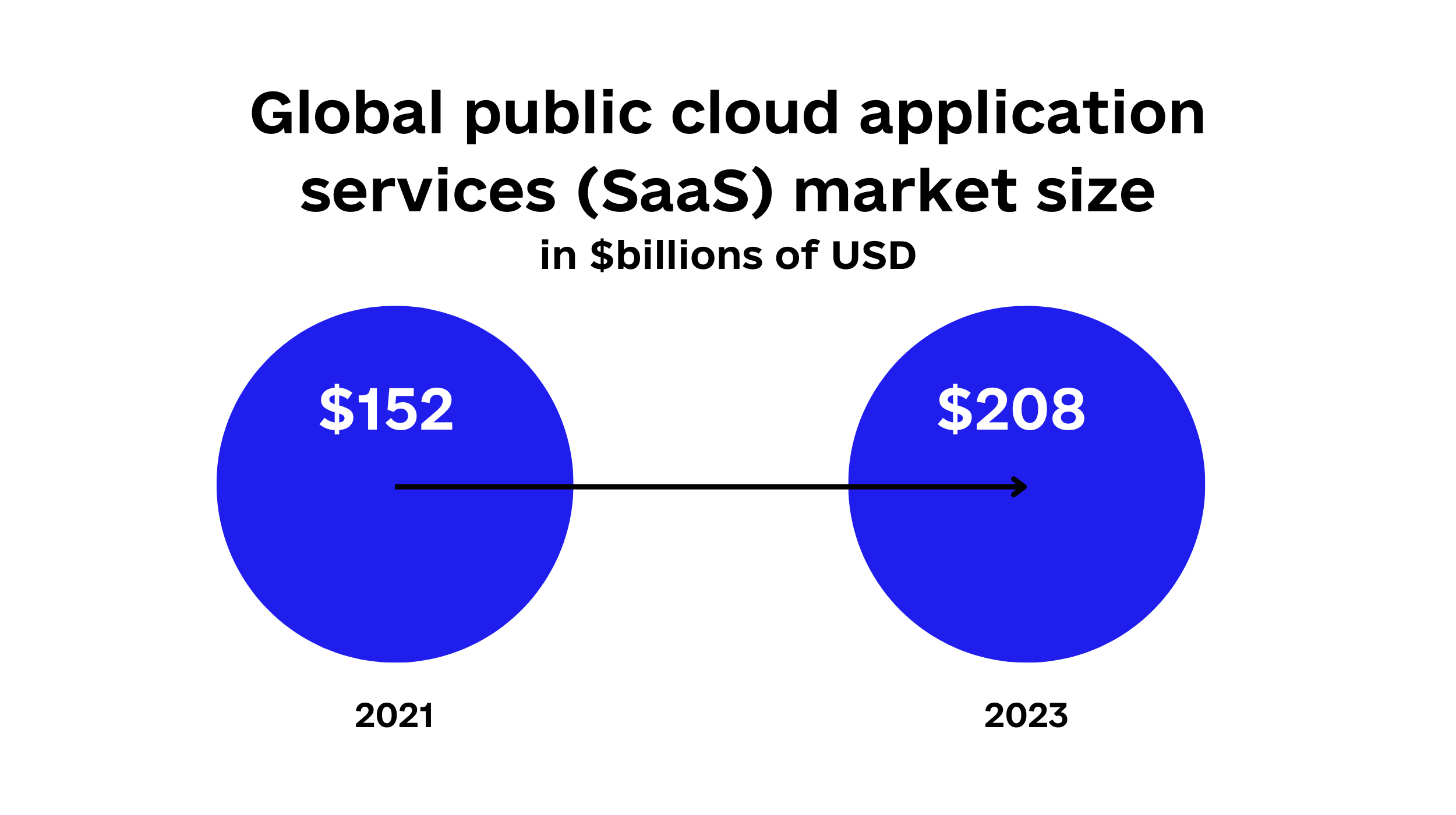
The U.S. is the leading Saas country by market share and boasts 8x more Saas companies than any other country. The U.S. has about 15,000 Saas companies, followed by the U.K’s 2,720, then Canada with about 2000 saas companies. Notwithstanding the general growth of the saas market, the U.S. market is projected to receive the most impact, with a forecast to grow from $98 billion to $202.5billion by 2025.
With most companies tilting towards wholly relying on SaaS systems for their business operation, SaaS providers’ future is quite promising. Fortune Business Insight has predicted that the global Saas market size is growing at a CAGR of 27.5 and be hit $716.52 billion by 2028.
Key Benefits of the SaaS Model
According to a survey conducted by BetterCloud, the top 5 reasons why most tech experts opt for SaaS sanctioned apps are:
- Cost
- Security
- Ease of use
- Integrations
- Customer Support.
However, to have a full grasp of how SaaS can be beneficial in today’s world, we will have to look at its advantages from the lenses of users and developers alike.
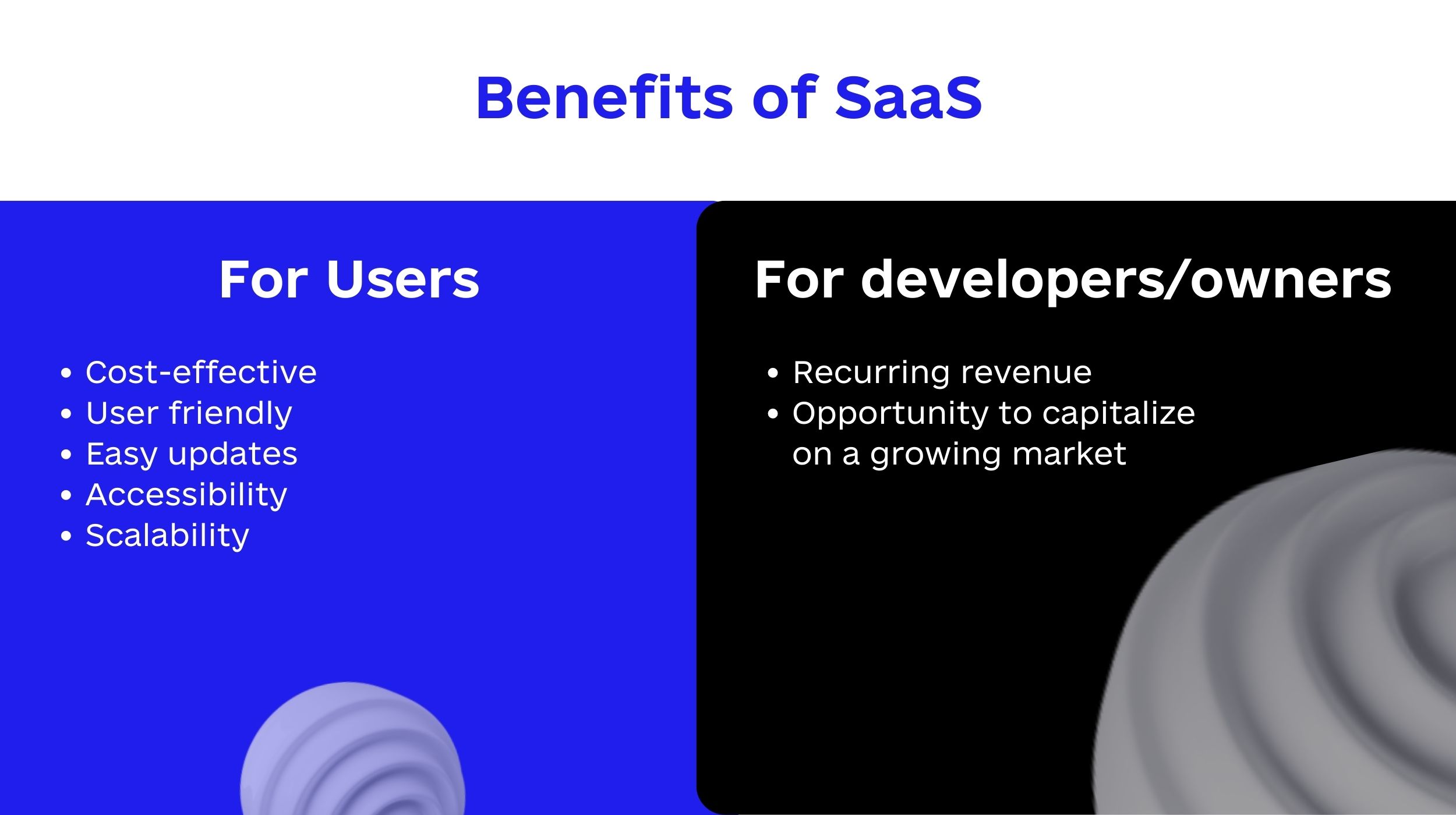
Benefits of SaaS for users
✔Cost-effective: the traditional licensing model entails a one-time license fee that is not affordable to small and medium enterprises in most circumstances. However, the saas model involves very convenient and flexible subscription packages that do not constitute any financial constraints to users. In addition, the subscription-based model allows users to maximize money spent on the app fully and can discontinue their subscription when they no longer need the app.
✔User friendly: one major issue for on-premise app was the requirement for installation, which was difficult for non-tech-savvy users. Saas apps have addressed this issue. Users only have to create an account and log in to access the app.
✔Easy updates: unlike on-premise apps where users are responsible for running updates on their software, the Saas provider takes care of running updates on Saas software. Since these updates are done automatically, it saves users the stress of having to download software before running updates.
✔Accessibility: Unlike op premise apps, saas apps can be accessed 27/7 and from any part of the world. The only requirement is a browser and reliable internet connection, and you are good.
✔Scalability: Saas apps are cloud-based, making it easy to scale and meet the changing needs of users.
Benefits for developers/ owners of Saas app
As a developer, you may be wondering: what are the benefits of creating a saas application? Below, we will love to share some benefits of developing a saas app.
✔Recurring revenue: the major benefit of the saas model to developers is the assurance of recurring revenue. Contrary to the on-premise model, where developers rely on the acquisition of software or the one-off licensing fee of their software to generate revenue, the saas model allows you to build a constant stream of income from the monthly/ Yearly subscriptions paid by users.
You only need to establish yourself in the market, and users will readily pay for the saas app while you focus on updating and updating the software to meet users growing needs.
✔Opportunity to capitalize on a growing market: the saas market is still emerging and yet to reach its full potential. Developing a saas app will allow you to grow with the market. According to BetterCloud, it is expected that more than 84% of business apps will be SaaS sanctioned by 2025.
Types of SaaS Applications
The more companies and businesses are tilting towards using saas modelled applications, the more different types of saas applications are introduced to meet industry needs. Below we will look at the categories of Saas software.
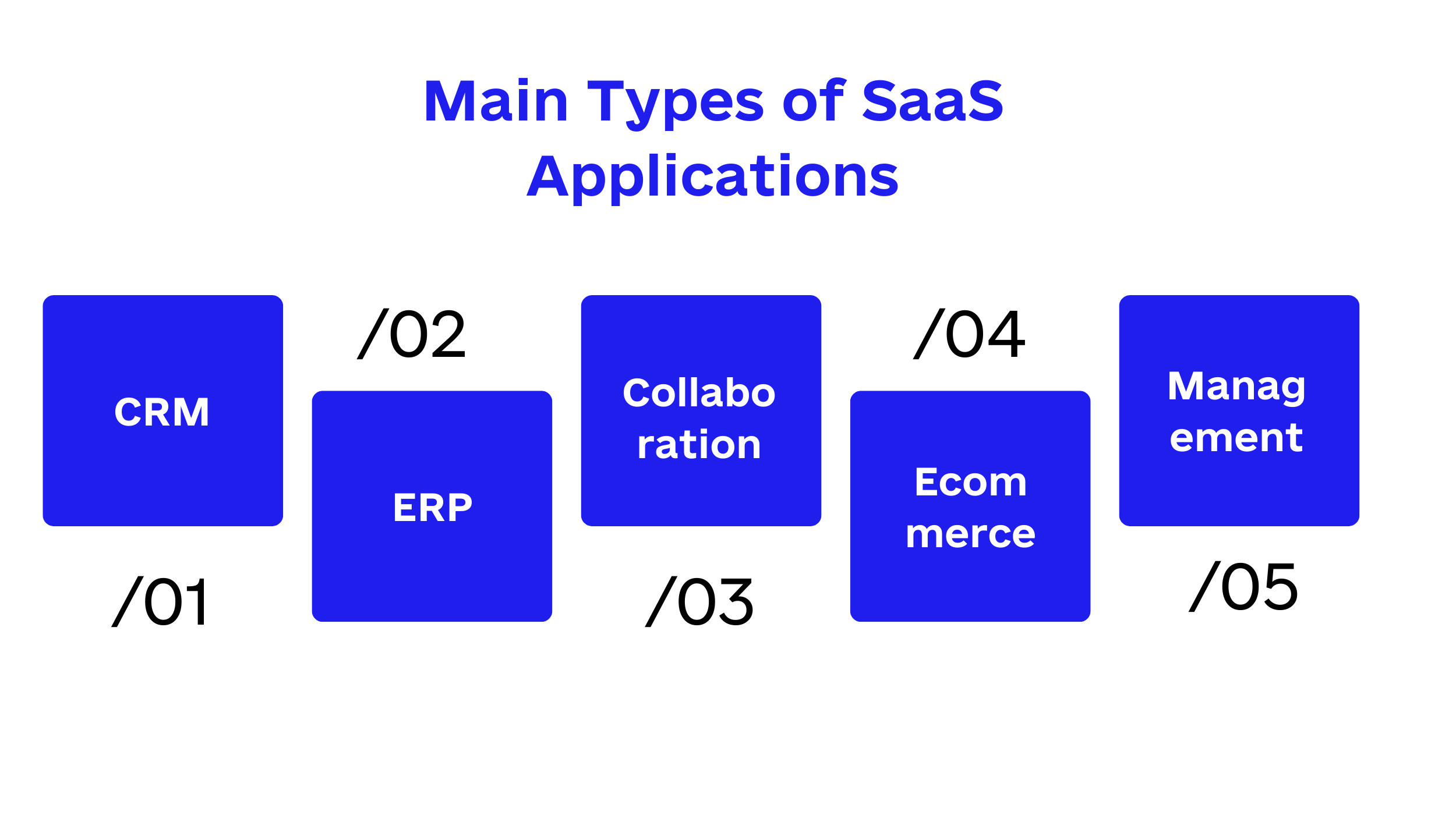
– CRM SaaS Software
CRM Saas software is a cloud-based customer relationship management software) that is designed to enable companies to provide a remarkable and convenient experience for their customers irrespective of location. CRM Saas software help companies build stronger relationships by improving customer interactions, tracking and automating sales, and managing and optimizing marketing opportunities. Popular CRM software includes Salesforce, Zendesk, Zoho, Pipedrive, Freshworks, Salesflare, Microsoft Dynamics, Hubspot, etc.
– ERP SaaS Software
ERP or Enterprise Resource Planning Saas software is a fast-growing cloud-based software used by companies and business organizations to manage their business operation in real-time. Also, the ERP Saas software help companies to plan, budget, forecast, and document companies and business organizations’ financial reports. The business operations managed by ERP include accounting, risk management, compliance, procurement, project management, shipping, inventory management, etc.
– SaaS Collaboration Software
A Saas collaboration software is a cloud-based software designed to improve communication, organization, and collaboration among team members or employees of a given company or business. The collaboration software enables team members to achieve the following:
- Brainstorm on ideas or policies
- Contribute to project
- Organize and assign tasks
- Communicate effectively
- And also track the progress of assigned tasks.
Some popular SaaS collaboration software includes Slack, Workplace, Confluence, Figma, etc.
– SaaS Ecommerce Platform
These cloud-based software solutions offer online businesses the opportunity to build their online stores without spending considerable resources on web/app development and design. A great example of Saas eCommerce software is Shopify. With Shopify, online entrepreneurs can build customized online shops for their businesses and access premium features and amazing themes for their stores. Saas eCommerce platform also provides payment gateway integrations to enable online payments for goods. Other Saas eCommerce solution includes Bigcommerce and Volusion.
– SaaS Project Management Software
This cloud-based software enables companies and business organizations to plan, allocate, schedule, and manage their projects or tasks effectively. In addition, project management software facilitates collaborations between team members and project managers. Popular saas project management software includes Jira, Trello, Teamwork Project, Proof hub, Basecamp, etc.
How to Build a SaaS Application from Scratch
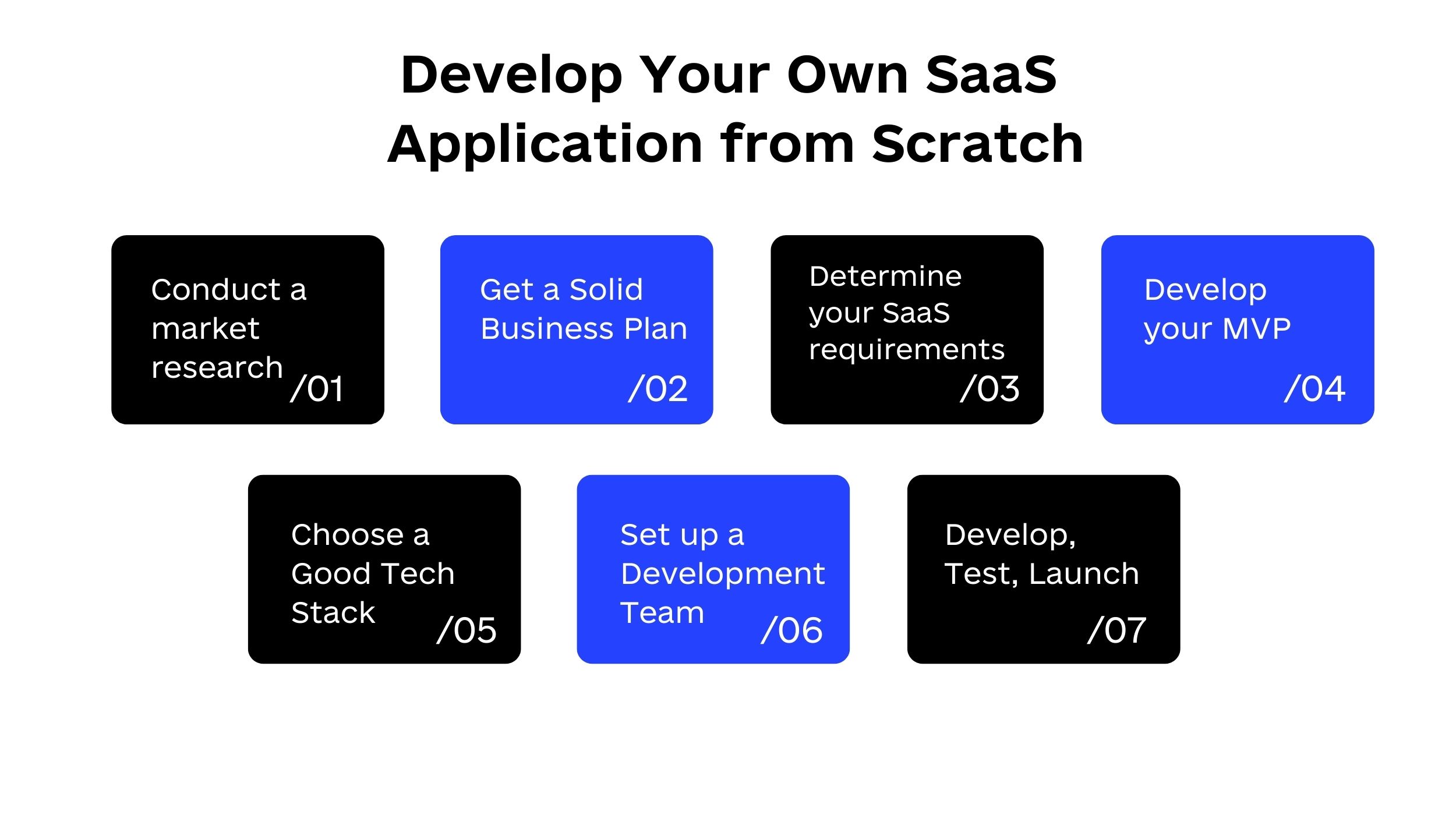
Step#1: Conduct a market research
Having great SaaS application ideas is not the same as having a viable idea. One way to find out where your idea belongs is to conduct market research. This is to help you understand how the specific niche you intend to serve operates. In this phase, your research should be concerned with answering the following question:
✅ What is the vision of my business idea?
✅ Who are the current players in my niche, and what makes them unique?
✅ Who are my potential target users, and where are they located?
✅ Are there specific needs users have that current players are missing?
✅ What are their current challenges with available saas products in the market?
✅ How will my product proffer solution to these challenges?
✅ What are the must-have features for my SaaS products
✅ What monetization strategies are currently in vogue in my niche, and how effective is it?
Working with answers from your research will help you understand the current market structure and create a product that can penetrate the market by addressing users’ needs.
Step#2: Get a Solid Business Plan
Your SaaS business idea is only as good as your business plan. Your business plan is the road map determining your path to success. Below are some key aspects to cover in your business plan:
Unique Selling Point: To penetrate the business niche you intend to venture into, you must be able to convince customers why your SaaS product is different from every other product in the market. To achieve this, you need to formulate what your unique selling point will be at the foundational level before you venture into the actual development process.
Universal value proposition: except you are coming into the market with an entirely new product; chances are there is already someone with a product similar to yours. However, if you must stand out, you need to clearly state the value your product will bring to customers in your market niche.
Monetization strategy: most developers get carried away with the intrigues of their business idea and forget to formulate a strategy for their SaaS product. If your product is not generating revenue, it won’t be long before you go out of business. For starters, here are some monetization strategies to consider for your SaaS product.
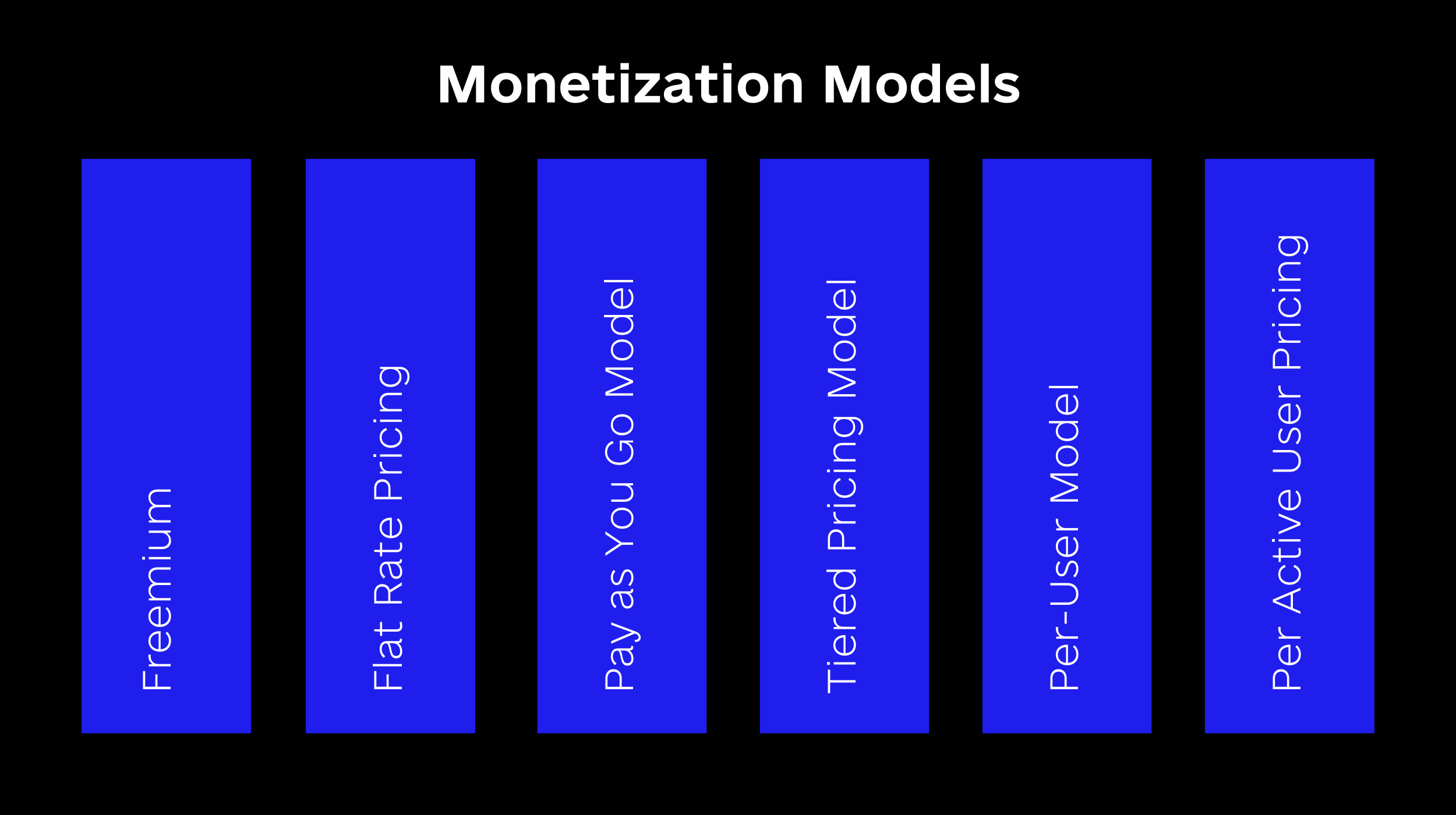
1. Freemium
This is a great strategy to help you, onboard users, into using your software. The idea is to allow users access certain basic features in your software but have the option to upgrade to access more features. The catch is to ensure users enjoy certain benefits that compel them to switch to the paid model to access more benefits. A perfect example of a SaaS company that uses this model is Shopify. Users get to set up their unique online and access Shopify features for 14 days before opting for a paid-for package. What Shopify does is to wow its users within the two weeks window. And that two weeks is enough for users to upgrade to a paid-for package to get more benefits.
2. Flat Rate Pricing
Flat rate pricing entails charging your users a fixed rate to access a set of features. SaaS products currently using the flat rate price strategy include Adobe, Basecamp, Precog, and Consider.
3. Pay as You Go Model
This is a usage-based pricing system that precisely links the value of a SaaS software to its usage: the more subscribers use the product, the higher their bills and vice versa. The pay as you go pricing model is currently being used by Chargify, ConvertKit, and SendGrid.
4. Tiered Pricing Model
The tiered pricing model is the most adopted pricing model by top SaaS companies. It is a pricing system where companies classify their services into different packages. The motivation behind this pricing model is to offer multiple choices to subscribers based on their needs and financial capacity.
HubSpot and Spotify are two mainstream SaaS companies that offer their subscribers this pricing model.
5. Per-User Model
According to Pacific Crest’s annual SaaS survey, the per-user pricing model is SaaS companies’ most used pricing strategy globally. In this model, a subscriber of a SaaS product is charged based on the number of users using the Saas Software. The more users utilize the app, the higher the subscriber’s price pays. A popular SaaS company that uses this pricing model is ProductPlan.
6. Per Active User Pricing Model
This is a species of per-user pricing model. Subscribers may opt for yearly subscriptions, but they are only billed based on the number of active users of the software. Slack is a perfect example of a SaaS company that uses this pricing model.
Step#3: Determine your SaaS requirements
The essential value you will offer end-users will be determined by the functionalities of your SaaS product. Although these functionalities will greatly vary depending on the business niche, you are focused on. Notwithstanding, they include the core requirement of a standard SaaS Software.
To add clarity to this, let’s consider some of the core requirements:
- Security Features
SaaS software is cloud-based, and since you will have to store a large amount of clients’ data in cloud storage, you must put in place high-security measures to curtail any form of malware or hacks. Some measures to include are Identity management, two-factor authentication, access control, etc.
- User-Friendliness
If there were one argument against on-premise apps that tops the chart, it would be its lack of user-friendliness, especially concerning installation protocols. SaaS applications are generally designed to make software usage seamless. Therefore, it would help make your SaaS application as customer-friendly as feasible. Customers will appreciate your ease of use if you provide straightforward navigation, a fast page load time, and an intuitive UI/UX design.
Note: Do not use complicated and massive text blocks, as well as a lot of J.S. scripts and CSS styles, as they will slow down the speed of your SaaS application, leading to high bounce off and low conversion rate.
- Support and Maintenance in Real-time
Like any other technology, SaaS solutions have bugs and glitches now and then. As experts, we advise that you use SaaS packages that provide continuous customer assistance services to help you tackle issues before they negatively impact users’ experience.
- Multi-tenancy Infrastructure
It refers to a system in which several businesses or tenants share a single SaaS installation platform. The multi-tenant security model is how you protect end users’ and organizations’ data within a shared environment of your multi-tenant software architecture.
Step#4: Develop your MVP
After determining the core requirements for the SaaS product, it is time to develop your MVP. The MVP represents a minimum viable product, and it is a limited version of your big idea. The concept of developing MVP is to help you test the waters of your business niche. Your goal for building an MVP should include the following:
✅ To accumulate feedback and validate your ideas: the purpose of developing an MVP is to help you get first-hand data from early adopters of your products on their experience interacting with your product. And to understand if users are eager to use your product. Imagine spending a huge amount of money building an application that does not solve users’ pain points? That would be a waste of resources. But developing an MVP will help you verify the viability of your app from users’ standpoint.
✅ Test Your monetization strategy: developing an MVP will enable you to try out different monetization strategies to find the perfect fit for your SaaS solution.
✅ To effectively pitch your idea: are you seeking funding for your idea? Developing an MVP is a must. With an MVP in hand, investors can feel what your idea is about and how users are interacting with the solution.
The purpose of Developing an MVP is not just restricted to verifying the features of your SaaS product but to validating the viability of your business model. Therefore, maximize your MVP to accumulate as much users’ feedback as possible, then use this information to strategize best on how to penetrate your market niche.
Step#5: Choose a Good Tech Stack
The technological stack is a set of computer languages, frameworks, and tools utilized to develop software. Today, technology offers a wide range of options from which to pick. As a result, figuring out how to construct a SaaS product and deciding on a solution stack is difficult. Another consideration is your software’s specialized requirements. As a result, it is difficult to suggest a specific framework to satisfy all your SaaS needs. However, in the latter part of this article, we will look at some of the best tech stacks to consider when building a SaaS product.
Step#6: Set up a Development Team
Now that you have gotten the preliminary stages out of the way, the next step is to assemble a team of developers to commence actual work. And there are three ways to go about it:
🔹 Hire an in-house developer
You can employ a SaaS developer to form part of your team. But to effectively achieve this, you may need first to find a technical partner or CTO to help you hire and manage the SaaS developer efficiently. However, this approach is deemed to be very time and cost-consuming, and as such, it is losing popularity among SaaS tech companies.
🔹 Freelancer
While this approach offers you some flexibility in terms of location, time zone, and cultural differences, it is not without its peculiar challenges. For instance, since the developer works remotely, it may be difficult to control and oversee the development process adopted by the freelancer. However, this approach can prove very beneficial with effective project management in place.
If you seek platforms where you can get freelance SaaS developers, you can start with Toptal, Upwork, Fiverr, Freelancer, etc.
🔹 Independent Contractor Company
Finally, you can outsource the development of your SaaS application to an independent development firm. You can outsource the development process to a team of experts who have hands-on experience building SaaS products. After executing several tasks, an independent development company has adequate experience and expertise to tackle complex requirements and deliver good results.
As a leading industry expert, we advise you choose a software development company to help bring your idea to life. Aside from helping you build your SaaS app, a software development company will also provide you with consultancy service services. You can save time and money by relying on their expert opinion on what you need or don’t need for your SaaS solution.
Step#7: Develop, Test, Launch
This step defines the real bringing to life of your SaaS product. You’re bringing all of your concepts together to create something that the market will embrace. At this stage, Avoid waiting till your SaaS solution is 100% complete before you start testing for bugs and code inconsistencies. Ensure testing is done alongside development. And that is why we encourage intending SaaS solution owners to work with an experienced software development company with Q.A. engineers on board to perform routine tests during development. Use the synthetic testing approach to simulate end-user interaction with your solution during testing. This way, you will quickly detect and arrest potential issues with your product before the end-users get affected.
Don’t relent on testing, maintaining, and improving your SaaS solution even after deploying your SaaS solution. One way to monitor your SaaS application performance even after deployment is by using real user monitoring. This type of performance monitoring captures and analyzes users’ interaction with your SaaS application in real-time.
How Does a Successful SaaS Product Generate Revenues?
Of course, your decision to own a SaaS solution is not hinged on charitable purposes. You certainly want to generate revenue while meeting real-life needs. Achieving this goal will involve knowing the monetization strategies that industry players are currently using.
Generally, SaaS companies favour a subscription-based model for their products. According to a survey conducted on industries leader from the USA, Asia, and Uk, over 70% of them believe that the subscription-based monetization model is the most preferred business model in their various industries. This could be why the subscription-based monetization model will generate $10.5 billion at a CAGR of 15.5% between 2019-2025. Below are some examples of subscription-based models that are in vogue:
- Freemium model
- Flat rate pricing
- Pay as you go
- Tiered pricing model
- Per-user model
- Per active user model
Feel free to try out different pricing models until you find the right fit for your application.
The Cost of SaaS App Development at Code&Care
You have concluded your research and have decided to build your SaaS application based on available data supporting the viability of your product. Now you want to determine the cost of developing your SaaS application and the length of time needed for development.
The fact is that there is no straightforward answer as the cost of development varies and depends on a lot of factors like:
🔹 The complexities and scope of your SaaS application
🔹 The number of features
🔹 API integrations
🔹 Choice of SaaS technologies and platform
🔹 Development time
🔹 Location of dedicated developers, etc.
On average, a SaaS application would take between 5-9 months to develop and cost anything between $24,000 to $400,000 and even more, depending on the factors listed above. For instance, working with an American or Canadian software development company, you may be paying between $150 to $250 per hour. In comparison, companies from eastern Europe are willing to charge between $45-$70 for a quality job.
Thus contracting third-party software development companies from Countries in eastern Europe would prove cost-effective. On Code&Care, we charge an hourly rate of $34.50 and a $4,800 monthly fee for extended team & staff augmentation.
Best Tech Stack for SaaS Applications in 2022
It is worthy to note that the choice of the technology stack used in developing your SaaS app will largely be determined by the software development company of your choice. Below we will look at the technology stack for key components of the SaaS application:
✔ The front end of a SaaS
HTML5, CSS3, and JavaScript are the most important technologies for front-end development. However, many frameworks lessen the physical input required to build your SaaS’s front-end.
For instance, bootstrap 5 significantly minimizes the amount of HTML input required. Simultaneously, the JavaScript ecosystem comprises various frameworks such as React.js, Angular.js, Vue.js, and dozens more.
✔ The backend of a SaaS
The choice of backend stack for your SaaS solution should comprise databases, languages and frameworks, security, business logic, and other components.
- Programming languages and frameworks: The most popular backend programming languages and frameworks are Python (Django, Flask), PHP (Laravel, Symphony), and JavaScript.
- Server: You will likely choose Apache, and Nginx, which could be running on-premises or in AWS, Google Cloud, or Microsoft Azure.
- Database: Examples include MySQL, Redis, MongoDB, and PostgreSQL, with a wide range of NoSQL and SQL databases.
- DevOps tools: Docker, Kubernetes, Jenkins, and others are needed to build Continuous Integration/Continuous Delivery pipelines (CI/CD).
Notwithstanding, whatever you do, ensure you choose a tech stack that is popular and well accepted in the industry.
Final Thoughts
Software as a service is still an emerging segment in the I.T Industry, but it boasts of massive potential. However, maximizing the potential of this segment by building a SaaS product is not going to be a jolly-free ride. But this guide will give you a headstart and help make your journey profitable.
If you would love to get more detail on building a custom SaaS product, don’t hesitate to contact us here. We will be glad to share our experience with you.
Read also:
How to Make a Site Like Pinterest That Exceeds Users’ Expectations
Tips To Build a Freelancer Marketplace Like Upwork
The Best Language to Build ECommerce Website That You Can Use in 2022
Cross-Platform Mobile Development: Advantages and Disadvantages [A Complete Guide]

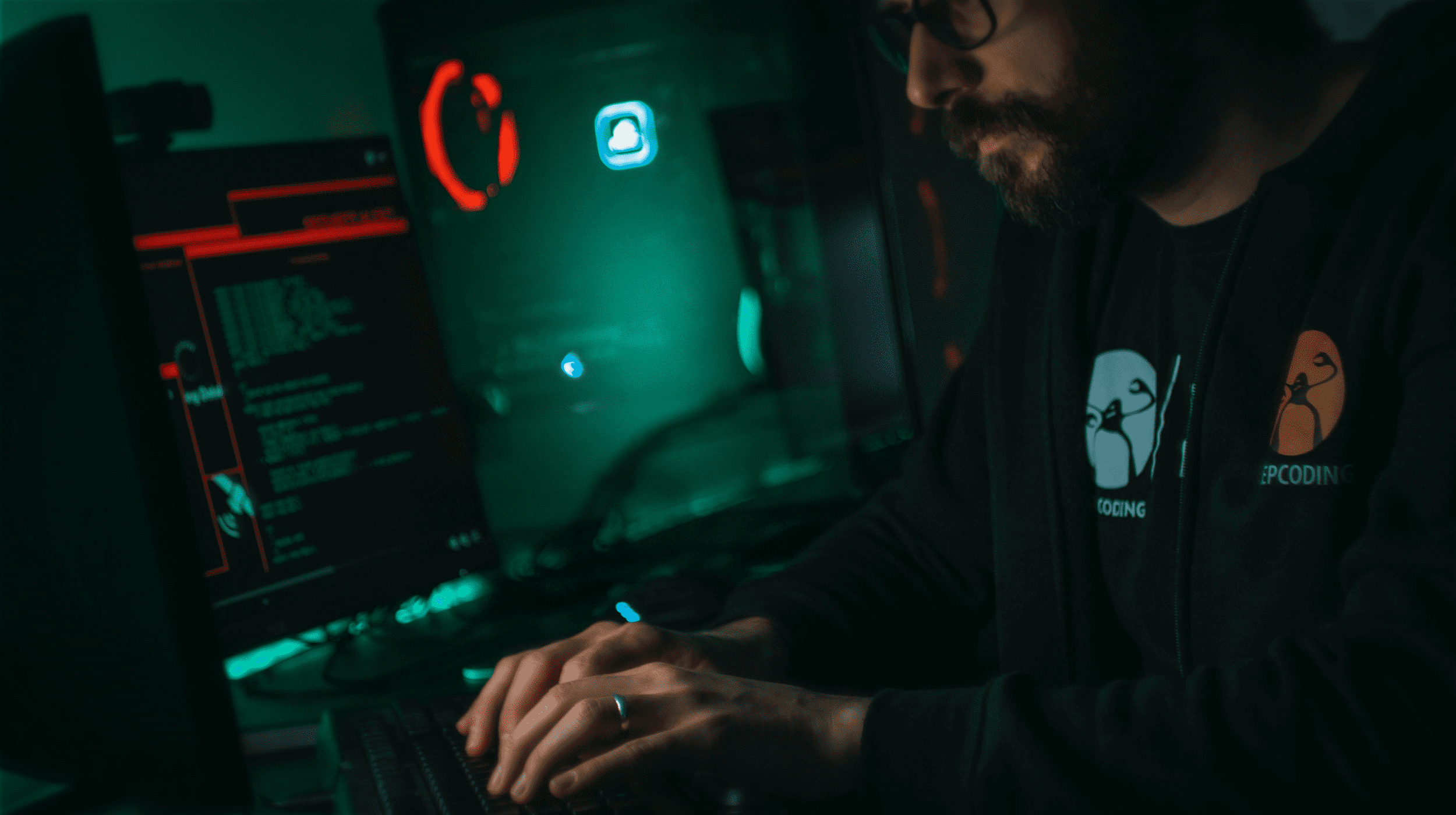






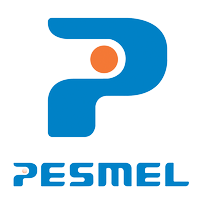

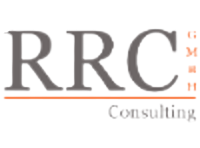



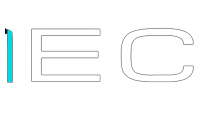

Popular
Latest